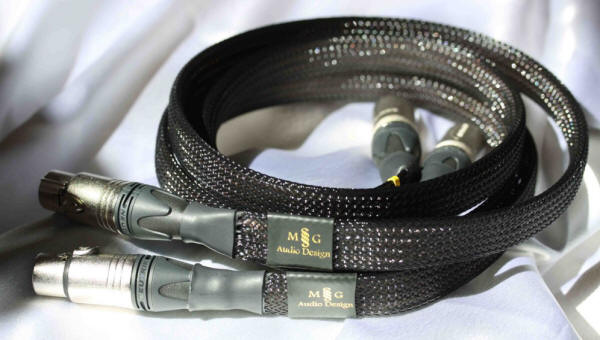|
You are reading the older HTML site
Positive Feedback ISSUE 67
The Neoteric Listener and the MG
Audio Design Interconnects and Speaker Cables
Interconnects, speaker cables, internal wiring––for many people, they're nothing more than exotic perfume. The mystical ingredients, the enticing design, the exasperatingly inexplicable pricing, all culminating in consummate joy... or one big stinking headache. After all, there's no quick and easy free sample vial for cables, and most of us need a speaker cable or interconnect that works with our system, not the one in the ad. Of course, almost all manufacturers claim their cables are as unblemished as the pools of Eden; any devilish noise you hear is merely the sins of your system. Unfortunately, it's a hell of lot easier to ditch the cable and keep the system than the other way around, so the cable courting continues. For this and other reasons, we read reviews like those by Robert Levi (who keeps a handy scorecard of the wires he's reviewed), seek the aid of dealers and cable supply companies, or follow the cable skirmishes on various online forums. Speaking of the latter, one of newest companies burning up the internet boards is MG Audio Design, whose speaker cables and interconnects are quickly garnering praise for producing responsive, invigorating sound at an eminently affordable price.
Greg Graff, self-described "COO/Chief Gopher" of MG Audio, was kind enough to send me a pair of their flagship Planus III speaker cables and a pair of their Planus Ag interconnects. I asked for interconnects and speaker cables because I hoped that auditioning both products would increase my understanding of what cable designer Lee Matuszczak is trying to achieve. For the review, I employed my usual set up of Nola Contender loudspeakers, CEntrance DACmini PX or Audioengine D2 DAC, and Peachtree Audio iNova integrated amp. As good fortune would have it, I was also able to pair the MG Audio cables with a PrimaLuna Dialogue Premium integrated tube amp, Clearaudio Concept turntable, and Audience One standmount loudspeakers in for review. For the most part, though, I stayed with the first system that I know so well, just to make sure that I was hearing the cables and not the new gear in town. I needn't have worried, though, as the MG Audio cables demand attention in any system. First off, let me opine that these interconnects are the proverbial B to break in, and the speaker cables are a royal pain to maneuver in my cramped, clumsy quarters. Even though the manufacturer put the Planus Ag interconnects through a torture test to provide some initial break in, pairing them with the wide-open sound of the PrimaLuna amp was one steady vacillating thrill-ride, shrill-ride. Some recordings sounded pretty good, in a bare-knuckle kind of way, but most were too bright for comfortable listening. Thus, the Planus Ag's were banished to the back room system until they could behave. As it took the better part of a month to bring them around, I turned my focus to the Planus III speaker cables. The speaker cables are flat, relatively stiff suckers that don't appear to like being twisted or contorted. I'm told by the manufacturer that the leads are fairly robust, and can be twisted and turned as needed, but the spade joint is the one you need to watch out. The spade lug terminations (one set made of silver for the amp connection, the other made of rhodium for the speaker) are joined by a conductor made of a thin copper foil that can be torn by rough handling. Understand, space and grace are both in short supply around my house, and I worried endlessly, as I threaded the speaker cable under, over, and sideways down the usual maddening obstructions that bedevil my audio rack. The Planus III speaker cables endured several months of reviewing acrobatics and lived to sing the tale. Under normal conditions, I wouldn't worry too much, but definitely proceed with caution. With these quibbles out of the way, let's get to the important matter of how these two products sound. Remarkably similar, it turns out. Both, interconnects and speaker cables, deliver a sound that is fast, taut, and engaging. There is absolutely no sense of midband bloat from either cable. The Planus Ag interconnects, for instance, cover up nothing, bringing every spec of the recording into the listening room. The MG Audio website warns that, "Like most silver wires, it has a hint of brightness in the upper midrange and thus may not be well suited to an already bright system," which normally would send me running, but something unexpected happened: the reveal was worth the wait! Compared to the other interconnects on hand (see my system description for names and notes), the Planus Ag's made them sound slow and overfed. True, my favorite Stereolab still sounds wonderful and full as always, but the Planus Ag interconnects made a fine showing next to the much more expensive pair. Like the Stager Silver Solid interconnects that I reviewed in Issue 47, the MG Audio product challenges the listener to go deep into the music and not just coast along. Naturally, the Planus Ag pair does so with far more depth and tonal balance, admittedly at a much greater cost than the budget priced Stagers. The retail price of $1100 for the unshielded, single ended locking RCA meter pair that I received seems very competitive for something that pulls the blinders off the music and lets it gallop. The Planus Ag interconnects are a blast to listen to because all of that sonic overlay is gone, leaving only your system in full view. If it all sounds like a bit too much for you, you can always go with the Planus CU2, which uses a copper material to provide a more "organic" sound.
Although the Planus III speaker cables ($1500 for my six foot pair) also need some time to be at their best, nobody will ever accuse them of being sleepy. Some may find their sound to be a little too wide awake, but just as many listeners will believe that few other cables, especially in this price range, are as good at conveying the energy and vibrancy of music. Compared to the warmer hue of the Kubala-Sosna Imagination cables in my system, the Planus III's tonal balance veers more towards the speed-and-resolution camp. Cable neutrality being the controversial bugger that it is, I won't make the leap and declare that the MG Audio cables give a clearer view of the music, but they sure take the gunk off the windows. Even on roughhewn tracks like Crybaby's "We're Supposed to Be in Love," the Planus III's show every bit of this pop pastiche (lead vocal from the Gene Vincent reverb school, fuzz guitar tone straight from the Electric Prunes, and drum tone from either a Selectric typewriter or a five dollar digital metronome), and yet it never sounds like anything less than music. I've been playing a ton of vinyl, some of it brand new audiophile approved new releases, but most of it the kind of scratchy, tick and pop manifestos (such as Manifesto) that come from decades of constant playing. The Planus III's let me hear all the whoops, leads, harmonies, and record skips of my moth eaten music treasures. It was entertaining as all get out. Via the Peachtree iNova integrated and Ray Samuel's F-117 Nighthawk phono stage, the MG Audio speaker cables delivered superb soundstage and imaging accuracy. Chad Kassem of Acoustic Sounds fame directed me to a bevy of vinyl wonders, including a stellar Quality Records Pressing 180 gram release of Ten Year's After A Space in Time. The album is a happening, man, of panning effects, studio effects, and Albert Lee's iconic acoustic and electric guitar work. The Planus III's easily captured the warm vocal and instrument vibe of this classic rock recording. These speaker cables effortlessly kept pace with the many spacing and dynamics production techniques used by the sound engineer to cook up the headphone candy for the 1971 listening audience. Naturally, the Planus III's had no trouble with easy stuff like the stage and audience ambience of "Kalimba" on Taj Mahal's Recycling the Blues and Other Related Stuff. In fact, all the live songs on that album clearly benefitted from the Planus III's excellent transparency and ability to represent soundstage. The sonic haze was skimmed without being skinned alive; a very addictive sound and one that I really enjoy. The PrimaLuna integrated is a remarkably expressive product, and the Planus III's conveyed that fact exceptionally well. I formed the impression that, if I really wanted to hear exactly what was going on with a tube change, say, or an exceptionally revealing speaker like the Audience Ones, then the Planus III's were the cables most likely to tell me the truth without editorializing. In the end, both the Planus Ag interconnects and the Planus III speaker cables are the sort of product that you miss when they're gone. I like my other cables, too, but it's undeniable that when I removed the MG Audio cables, I remarked, "Well, that sounds boring!" Given what they accomplish at their price, the Planus Ag interconnects are a joy to hear, and the Planus III's are simply a marvelous accomplishment. Recommended.
Planus Ag interconnects
MG Audio Design
|


